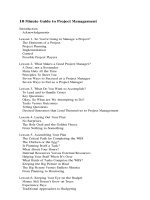Crisis Management doc
Bạn đang xem bản rút gọn của tài liệu. Xem và tải ngay bản đầy đủ của tài liệu tại đây (807.7 KB, 92 trang )
06.05
OPERATIONS
Crisis
Management
Jack Gottschalk
■
Fast track route to understanding crisis management
■
Covers the key areas of crisis management from crisis planning
and handling a global business crisis to crisis plan execution
■
Examples and lessons from some of the world’s most successful
businesses, including Parsons Corporation, Pepsi Cola, Johnson
and Johnson and General Motors, and ideas from the smartest
thinkers, including Douglas Hearle, James E Lukaszewski and
Fraser P Seitel
■
Includes a glossary of key concepts and a comprehensive
resources guide
06.05
OPERATIONS
Crisis
Management
■
Fast track route to understanding crisis management
■
Covers the key areas of crisis management from crisis
planning and handling a global business crisis to crisis
plan execution
■
Examples and lessons from some of the world’s most
successful businesses, including Parsons Corporation, Pepsi
Cola, Johnson and Johnson and General Motors, and ideas
from the smartest thinkers, including Douglas Hearle, James
E Lukaszewski and Fraser P Seitel
■
Includes a glossary of key concepts and a comprehensive
resources guide
Jack Gottschalk
Copyright Capstone Publishing 2002
The right of Jack Gottschalk to be identified as the author of this work has been
asserted in accordance with the Copyright, Designs and Patents Act 1988
First published 2002 by
Capstone Publishing (a Wiley company)
8NewtecPlace
Magdalen Road
Oxford OX4 1RE
United Kingdom
All rights reserved. No part of this publication may be reproduced, stored in a
retrieval system, or transmitted, in any form or by any means, electronic, mechan-
ical, including uploading, downloading, printing, recording or otherwise, except
as permitted under the fair dealing provisions of the Copyright, Designs and
Patents Act 1988, or under the terms of a license issued by the Copyright
Licensing Agency, 90 Tottenham Court Road, London, W1P 9HE, UK, without
the permission in writing of the Publisher. Requests to the Publisher should be
addressed to the Permissions Department, John Wiley & Sons, Ltd, Baffins Lane,
Chichester, West Sussex, PO19 1UD, UK or e-mailed to
or faxed to (+44) 1243 770571.
CIP catalogue records for this book are available from the British Library
and the US Library of Congress
ISBN 1-84112-283-1
This title is also available in print as ISBN 1-84112-215-7
Substantial discounts on bulk quantities of ExpressExec books are available
to corporations, professional associations and other organizations. Please
contact Capstone for more details on +44 (0)1865 798 623 or (fax) +44
(0)1865 240 941 or (e-mail)
Introduction to
ExpressExec
ExpressExec is 3 million words of the latest management thinking
compiled into 10 modules. Each module contains 10 individual titles
forming a comprehensive resource of current business practice written
by leading practitioners in their field. From brand management to
balanced scorecard, ExpressExec enables you to grasp the key concepts
behind each subject and implement the theory immediately. Each of
the 100 titles is available in print and electronic formats.
Through the ExpressExec.com Website you will discover that you
can access the complete resource in a number of ways:
» printed books or e-books;
» e-content – PDF or XML (for licensed syndication) adding value to an
intranet or Internet site;
» a corporate e-learning/knowledge management solution providing a
cost-effective platform for developing skills and sharing knowledge
within an organization;
» bespoke delivery – tailored solutions to solve your need.
Why not visit www.expressexec.com and register for free key manage-
ment briefings, a monthly newsletter and interactive skills checklists.
Share your ideas about ExpressExec and your thoughts about business
today.
Please contact for more information.
Contents
Introduction to ExpressExec v
06.05.01 Introduction 1
06.05.02 What is Crisis Management? 5
06.05.03 Evolution of Crisis Management 9
06.05.04 The E-Dimension 17
06.05.05 The Global Dimension 25
06.05.06 State of the Art 33
06.05.07 In Practice 45
06.05.08 Key Concepts and Thinkers 63
06.05.09 Resources 73
06.05.10 Ten Steps to Making it all Work 79
Frequently Asked Questions (FAQs) 89
To Mom and ‘‘Misty.’’
06.05.01
Introduction
A description of the need for crisis management in the public and
private sectors, and in both the for-profit and not-for-profit areas.
2 CRISIS MANAGEMENT
‘‘Great crises produce great men and great deeds of courage.’’
John F. Kennedy
Why is crisis management important? Simply put, without it, and
without a plan to accomplish necessary goals, crises grow and rela-
tionships are damaged in the long term, short term, or both. And
no organization is immune. Private sector for-profit companies can
lose customers, while not-for-profit groups can lose credibility and
members. Governments, too, can suffer. Agencies can have trouble
getting funding having once lost the confidence of the executive or the
legislative branches. Elected officials can lose their jobs the next time
that the voters go to the polls.
In short, when something goes wrong, no matter who is at fault
and regardless of the reason, someone must tell the story as quickly
as possible. Will there be a ‘‘spin’’ on that story that will make the
organization look good? Probably. But that’s not necessarily bad as long
as there aren’t lies and deliberate distortions that will come back to
haunt the organization later.
If an organization has just had a disaster that killed and injured a lot
of people or poisoned the environment, there will be no question that
the incident happened. When any organization talks about its plans for
taking care of victims and to help make things right, that’s a good thing.
If that’s considered to be putting a ‘‘spin’’ on a story, so be it. Ducking
the issue or letting the media or the government tell the public about
a crisis or its underlying causes is never a good idea.
The future is, of course, here. We live more, every day, in a global
society that is increasingly held together by a complex system of linked
and rapid communications. When the oil tanker goes onto the rocks in
Alaska, or when a plant explodes in India, or when an airliner crashes
into Long Island Sound, the world media knows about it with lightning
speed. The world learns about the incident only minutes later. And
both the media and the public will be impatiently waiting for accurate
information, including explanations for the event, immediately.
The task of meeting that challenge falls to the people who plan, and
are responsible for carrying out, effective crisis management operations.
Particularly in the US, the media and the general public take the ‘‘right
to know’’ as an article of faith. It can safely be assumed that this
INTRODUCTION 3
desire will be increasingly observed around the world as capitalism
and associated democratic government inexorably spread. Thus, the
need to be ready to communicate when things go wrong, to engage
in crisis management, will continue to be an ever-increasing part of
management’s responsibility during the twenty-first century.
06.05.02
What is Crisis
Management?
What the terms used really mean and how to understand the differences
between them.
6 CRISIS MANAGEMENT
The first problem, when dealing with the various definitions of crisis
management, is to understand what the activity really is, and who are
the people engaged in it.
One definition, albeit not the only one that has been offered to
describe an imprecise activity, has been provided by Larry Smith,
president of the Kentucky-based Institute for Crisis Management. His
view is that a crisis of the type dealt with in this book is:
‘‘A significant business disruption which stimulates extensive news
media coverage. The resulting public scrutiny will affect the orga-
nization’s normal operations and also could have a political, legal,
financial, and governmental impact on its business.’’
CRISIS ACTION PLANNING
In one sense, particularly at the highest levels of government, crisis
management can easily be viewed as creating tactics to deal with a fast-
developing situation with national security ramifications. The people
who make their living dealing with such things have essentially given
this kind of problem-solving an official date of creation – October 1962.
The occasion of its birth was the Cuban Missile Crisis and the group
involved in the crisis management was the Kennedy White House.
Academics and government officials have come to label this activity
‘‘crisis action planning,’’ but it is sometimes given a shortened title
of ‘‘crisis management,’’ a fact that does have a definite tendency to
confuse.
EMERGENCY PLANNING
The term ‘‘crisis management’’ is also used, incorrectly as far as the
purpose of this book is concerned, to describe those activities that
involve what must be done before and during some kind of emergency.
Thus, when the factory catches fire, the efforts to ensure that the
workers can escape and that the blaze can be extinguished, are often
thrown into the over-arching term of crisis management as opposed to
what it really is in such a case, namely ‘‘emergency management.’’
Another example reinforces the distinction between crisis manage-
ment and emergency management. When the lights go out in the
WHAT IS CRISIS MANAGEMENT? 7
accounting department for a few hours on pay-day, that’s an emer-
gency which quite clearly causes great inconvenience, but, when plant
number three in North Carolina, or Rome, or Caracas, explodes with
a deafening roar and pushes some horrible chemical five miles up into
the sky for all the world – and the media – to see, that’s a crisis that can
imperil the very survival of an organization.
DIFFERENCES AND MYTHS
What sets crisis management, in a public relations sense, apart from
both crisis action planning and emergency management is its media
aspects. There is a recognized need to inform the public about the
problem, generally through the news media, how it is being handled,
why it happened, and how it will affect people.
Thereisnot,bytheway,anyrealbeliefonthepartofcrisis
management consultants or executives that what they do will result in
the public learning to love their organization. People do not like any
organization, regardless of what it is, any better when it is honest with
them. When, for example, PepsiCo proved that it wasn’t responsible for
insulin syringes turning up in some cans of its products, or when Gerber
proved that there was no way it could have put glass in baby food,
customers did not lovingly embrace the corporate entities involved.
And that’s okay, because the real driving motivation behind crisis
management efforts is not to make people love a company or any other
kind of organization. The idea is to reach out to the various critical
publics – the media, customers, financial community, shareholders,
government – and not have them like the entity any less.
Anyone who says that crisis management, regardless of how effective
it proves to be, will help an organization to be cuddled by society, has
been living in a cave for a very long time.
PUBLIC RELATIONS, CRISIS, AND THE NEWS
MEDIA
The root of crisis management, again using the term in the sense being
discussed in this book, comes from the skills that have been honed over
the years by consultants and executives in the communications and
public relations field. For the truth is that no matter how one tries to
8 CRISIS MANAGEMENT
look at this activity, unless an organization reaches the biggest number
of people possible with its version of events during a crisis, the crisis
management effort fails. And the only real way, in the vast majority of
situations, to reach a lot of people fast, is through the news media via
the reporters and editors who make that system work.
Obviously, paid advertising can be, has been, and is, used to reach
people. When the tire issue involving Firestone went into high gear,
Ford Motor Company featured its CEO in a series of TV ads. He talked
about how Ford was both determined and dedicated to having safe tires
on its vehicles. There is at least some anecdotal evidence to suggest
that a news story in The New York Times would have carried more
credibility than the words of a Ford executive, but that is an arguable
issue.
On the same point, and dealing with the same crisis, the new CEO of
Firestone was also featured on TV ads attempting to convince viewers
that ‘‘when the rubber hits the road’’ it will remain on the tires.
Only time will tell if these crisis management, public relations-oriented
efforts, generated from a huge crisis, will prove successful.
A rule of crisis management, of course, is that people must be
informed and that such communication be accomplished before some-
body else, for example, the government, does it. There is no doubt that
when any organization reaches out to the public to tell its story, it will
try to do it without making a bad situation worse. And so it has come
to pass that the media and others have created labels for application to
the communicating public relations consultants, executives, lawyers,
and anyone else involved in getting a story out. The labels run from the
mildly offensive to the downright corrosive, including ‘‘spin masters,’’
‘‘spin doctors,’’ and ‘‘flacks.’’
The real point is that when things go wrong, somebody has to do
something. And there is nothing wrong with an organization trying to
inform the public with its version of a disaster and with the greatest
extent of honesty and truth that can be provided. No organization,
private or public sector, can afford not to communicate, and not to do
it with skill. In a crisis, silence is not golden.
06.05.03
Evolution of Crisis
Management
How crisis management has developed, using selected crises of modern
history to illustrate successes and failures.
10 CRISIS MANAGEMENT
There have always been disasters of the character that, today, would
trigger crisis management efforts. Among them, during the twentieth
century, would be: the sinking of the Titanic in 1912; the Teapot Dome
scandal of the 1920s; and the widespread labor troubles that plagued
America during the years immediately following World War II.
A list of the number of incidents over the years would be a long one.
They have involved organizations and individuals, and they have been
marked by one interesting thing – there was no crisis management,
certainly of the type practiced today.
Certainly,therewasadesireonthepartofaffectedorganizations,
such as the New York Stock Exchange, National City Bank, White Star
Line, and Sinclair Oil, to avoid or limit damage to corporate interests
caused by newspaper headlines. And there were, without question,
discussions between executives and newspaper publishers and editors
that may have helped in that regard.
But there is no real evidence to show that organizations faced with
disaster took steps that were based on any crisis plan, or tried to get to
the news media ahead of the story with a less damaging and perhaps
helpful version of events.
THEN AND NOW
Public relations, though at the time of its earliest use it was not blessed
with a name, has its roots in the need to communicate with large
groups of people and to try to win them to a cause. The Greeks and, to
a greater extent, the Romans, used communication techniques to rally
the masses. The Roman Catholic Church was an early master in the use
of mass communication to ‘‘propagate’’ the faith, a term that led to the
word ‘‘propaganda,’’ which, in reality, is what public relations is all
about.
The availability of printing put a lot of wheels under the commu-
nication process, giving anyone with access to a press the means to
reach huge numbers. This ability also created substantial problems for
established government and led to attempts at censorship because of
the (correctly assumed) fear that when people have a lot of information
theycanbehardertocontrol.
This fact, of course, was no better proved than in the days of colonial
America when a number of people, among them Samuel Adams, began
EVOLUTION OF CRISIS MANAGEMENT 11
to raise hell with the established order. When the Civil War started,
Thomas Paine, a pamphlet writer in the employ of Washington’s army,
did his bit to push the soldiers and the general population (a substantial
percentage of whom were either loyal to the British Crown or didn’t
particularly care about who won) into a patriotic fervor.
Business, however, tended to ignore the use of mass communication
as a means of winning the hearts and minds of the masses until well
into the second industrial revolution, which began after the end of the
Civil War.
It cannot be said that the media of the time ignored business. As
John Steele Gordon, in his book The Scarlet Woman of Wall Street,
noted as one example, a New York Times editorial of November 19,
1868, dealing with the Erie railroad scandal, which read:
‘‘England and France have had their speculative bubbles, their
gross violations of trust, their robbery of confiding stockholders
by men high in position, and with riches in abundance. But neither
England nor France presents a parallel to the infamies of the Erie
railroad.’’
The fact, of course, was that no major corporation or business leader
was going to be damaged by a negative press. It was, truly, the era, as
one of the Vanderbilts said in anger to an inquiring reporter, in which
business could and did take the position that ‘‘the public be damned.’’
But that was to change as government and the media began
confronting big business interests that were, by the turn of the
twentieth century, being considered as a national threat. As a bigger
government, armed with bigger regulatory teeth, a president (Theodore
Roosevelt) armed with a big stick, and investigative writers took aim at
business leaders, they realized that something had to be done to make
them appear to be warm and cuddly. Ivy Lee, probably the nation’s
first real public relations professional, told the media that he would
provide about and on behalf of his clients: ‘‘prompt and accurate
information concerning subjects which are of value and interest to the
public ’’
It is, of course, extremely difficult to pluck an event from history
and then place it into a modern frame of reference for purposes of
comparison. But, it might work here and in any event, we’ll try.
12 CRISIS MANAGEMENT
If, on a dark and stormy night in the fall of 1932, a fully-loaded oil
tanker had collided with some rocks off Alaska, or bounced off a sand
bar in the Gulf of Mexico, with the result that thousands of furry little
seals were drowned in the oil slick, there would not have been a crisis.
The story might have been reported (and perhaps not) but few people
would have cared. And no one would have seen the furry creatures or
the oil-soaked birds flapping in the black water.
In the same vein, while there was an understandably high level of
patriotic interest in how well we were doing during World War II, there
were no pictures of dead US soldiers released to American audiences
until 1943.
Another example, perhaps apocryphal but relevant, is the oft-related
story of two military officers who showed up right after a twin-engine
bomber hit the 79th floor of the Empire State Building on Saturday, July
28, 1945. One said to the other: ‘‘What shall we tell the press?’’ The
senior officer replied: ‘‘Deny everything.’’
Whether that story is true or not, another example is a matter of
fact. During the dark days of the Cold War, the US government did
have a plan that called for national press censorship in the event of
emergency. And there was a manual on how to conduct it. One of the
rules was that if there was an atomic attack on the US, the news should
not be released to the media.
The currently, and widely, recognized need to open and maintain
communication channels with the public took a while to gain accep-
tance. Even today, as will be seen, a lot of organizations are not
committed to the idea. If it were not for the fact of lightning-fast
and multiple types of telecommunication, most organizations, instead
of only some, would still avoid having to inform. It’s not in most
organizations’ genes.
Remember that delay of getting pictures of dead soldiers into the
hands of the American public in World War II? Compare that with
the endless TV shots of body bags that were visited upon Americans
in their living rooms during most of the years of the conflict in
Vietnam.
By the 1950s, the American public expected to be kept informed
about most things. The newspapers were fewer in number and they
were giving way to the immediacy of radio. And by the 1970s, television
EVOLUTION OF CRISIS MANAGEMENT 13
had mounted the throne as king of journalism. It would stay there, with
the change being in the form of networks to some extent being replaced
by, for example, CNN.
Government had to learn to live with these changes and, to some
extent, it did that better than the private sector. Generally, public
relations people in government are news sources and they meet with
the media on a continuing basis. They have long ago learned how
to ‘‘leak’’ information, conduct ‘‘deep background’’ briefings, how to
hold news conferences, and how to make and maintain news media
contacts.
Practice doesn’t always make perfect, but it helps. The private sector
has a different set of problems and, to a large extent, significantly less
experience. Most companies, even the biggest of them, are not sources
of real news. They do try to be and they are always ready to issue
publicity releases on people who are getting promoted, what new
products or services are being offered, and how good the profits
are, particularly the after-tax ones. A relatively small amount of this
information gets into the newspapers except for the business journals
and far less gets onto the TV screens.
TEXAS CITY
But the private sector was not ignorant of the need to communicate
in a disaster; at least that was true of some companies. The first crisis
management plans were in place at least as early as the late 1940s and
were created by some of the major banks, chemical companies, and
airlines.
One grim day in April 1947 brought the example that proved the
need for crisis communication. Texas City, Texas, was the place. A
ship blew up in the harbor and that explosion caused massive fires and
more explosions at the nearby Monsanto Chemical plant and in several
oil refineries, one of which was operated by Humble Oil, a part of
Standard Oil Company. The resulting destruction and loss of life made
national headlines. If there were crisis plans in place, there is scant
evidence of their effective use.
But there are far worse cases that can be used as examples of
poor crisis management or a downright corporate lack of interest in
communicating to the public.
14 CRISIS MANAGEMENT
‘‘LOVE CANAL’’
Once upon a time, for those who cannot remember, there was a toxic
dump near Niagara Falls, NY, that was used and abused by Hooker
Chemicals & Plastics Corp. from 1947 to 1952. After its complete
contamination of the site, Hooker sold the poisoned ground to the
Niagara Falls Board of Education in 1953. As late as 1992, Hooker and
its successor company, Occidental Petroleum, didn’t want to talk about
the site, which came to be well known by the name ‘‘Love Canal.’’
Would Hooker have been better off in the eyes of just about everyone
if it had accepted responsibility for the use as a toxic sewer? Sure. But
it didn’t. Did it matter? Ask the people at Occidental.
A LITTLE BENZENE
Perrier, well-known for its expensive little green bottles of water, took
cover when benzene was found in some of those containers in 1990.
Did it hurt Perrier? Maybe, for a little while. Most people forgot the
whole thing anyway.
THE TWA CRASH
When TransWorld Airlines (TWA) had a plane go down into the waters
off Long Island a few years ago, it was roundly (and wrongly) criticized
by some people in the media because it did not immediately release
the names of the passengers on the manifest. The airline took the
position that it had to check the manifest to be sure it was correct
and then it had to reach family members before giving that list to the
media.
And then TWA held a news conference that had to be one of the
greatest crisis management disasters on record. It was done live in a
hangar and conducted by airline executives who seemed to have no
concept of how to deal with the media in a crisis atmosphere.
Did the handling of the disaster hurt TWA? Maybe, but if the
company was damaged, there were other causes. There is a point to be
remembered. Maybe Occidental wasn’t hurt by Love Canal. People still
order Perrier water. People still buy TWA airline tickets.
But if there is another major disaster involving any of these companies
and it doesn’t get its story out to the public via the news media fast,
EVOLUTION OF CRISIS MANAGEMENT 15
the reporters and the editors will be reminding the public of what
happened before.
DOING IT RIGHT
But there are good examples of dealing with the public in a crisis as
well as bad ones. Johnson & Johnson and the Tylenol poisonings, and
Gerber Products Company, Inc. and the allegations of glass in its baby
food, are illustrations of how to do things right. Both cases will be more
fully examined later.
The Tylenol case, of course, stands out as one of the first product-
tampering crises and Johnson & Johnson gained a permanent position
as a pioneer in dealing with that sort of problem. It took the product
off the retail shelves, it talked to the media, and it communicated with
customers, and other target groups.
Gerber took similar action when confronted with false claims
about glass in its baby food. But it did not take the product off
the shelves because, had it done so, corporate financial disaster could
have followed.
Both companies knew what they were doing and what they had to
do to survive these crises. Again, they were not loved by the public but
they did survive and prospered.
The key point is that if the management of any organization refuses,
for any reason, to talk about its people, products, or services, or about
any problems that can affect the public, it runs a very real risk of not
being trusted at all. That is the reason for effective crisis management.
A time-line follows showing some key incidents and dates. Several
of the noted incidents will be presented as case histories in Chapter 7.
TIME-LINE
» 1947: Texas City explosion and fire. A major disaster with seemingly
minimal crisis management involvement.
» 1979: Three Mile Island. Too many people trying to talk to the media
with resulting confusion. One individual must be designated as the
spokesperson in a crisis.
» 1982: The Tylenol product-tampering. A milestone case with a
company, Johnson & Johnson, doing virtually all things right.
16 CRISIS MANAGEMENT
» 1989:TheExxon Valdez oil-spillage disaster. Confusion and lack of
information in the midst of chaos. Exxon spent a lot of time, energy,
and money to prove, before the crisis, how responsible and open it
was. And then the ship, literally, hit the rocks.
» 1996: Parsons Corporation loses its CEO in a widely reported plane
crash. Its planning for such news and its execution of the plan are
excellent examples.
» 1999: Crisis management insurance cover is made available.
06.05.04
The E-Dimension
How new means of communication have impacted crisis management
in terms of challenges and responses.
18 CRISIS MANAGEMENT
There are several parts of this subject which apply not only to crisis
management but also to the entire area of mass communication.
Clearly, one of the first considerations is that news, good or bad,
travels with frightening speed. What this can mean is that a company
with far-flung operations may easily be placed in a position of not
havingenoughadvancenoticetobeabletorespondtoastoryabout
itself. If the concept of trying to get out in front of a story is a viable
one, the practical fact is that it may be harder to accomplish now than
itwasonly10yearsago.
The ability of the news media to cover stories and to get the story
out around the region, nation, and world, has also been enhanced by
the use of e-mail, faxes, cell-phones, and the computer. One example of
how these inter-linked technologies have changed things is to examine
the news coverage of American military actions in a combat zone in a
modern sense.
THE MILITARY GIVES UP
In virtually every conflict involving American military forces since
the end of the Mexican War of 1848, except for Vietnam and it
was considered there, military news from the front was subject to
censorship. The telegraph lines were monitored during the Civil War,
and there was naval censorship of the cables sent by the press from
Key West, Florida, New York City, and Washington, DC, during the
Spanish–American War. The media was also censored by the military
during the US intervention in Vera Cruz in 1914. Censorship of the
press was conducted in France during World War I and in every theater
of operations during World War II and, later, in Korea.
But by the time of the Gulf War, the idea of censoring a correspon-
dent’s material was so difficult to accomplish that the entire censorship
organization, known as the military’s Wartime Information Security
Program (WISP), was abandoned. It was replaced by a far more loosely-
organized news management system that worked only because the war
was so short.
Why the change? There was no way to effectively censor, no matter
how important that might be, given the electronic resources that
were available to the news media, including private communication
satellites.
THE E-DIMENSION 19
IT’S NOT JUST SPEED
But it’s not only speed and better communication tools that make the
e-dimension an area of concern to the folks in crisis management,
it’s also the potential (and the reality) that now exists to attack any
organization and do it in a public forum. The attackers, current or
potential, are out there in cyberspace.
In its April 12, 1999 issue, Business Week, in an article entitled ‘‘A
Site for Sore Heads,’’ explored the problem of ‘‘e-attacks’’ that must
now be confronted. One example was that of an unhappy customer
of a Wal-Mart store. So unhappy, in fact, was the customer that he
created walmartsucks.com. This Website platform, according to the
magazine, has been used by a lot of people (some 1500 customers and
employees) to file complaints and other communications against the
company. Of course, not everybody can take a joke and Wal-Mart went
to its lawyers for an answer. The lawyers, of course, threatened action
and the Website operator basically told them to get lost. In an apparent
attempt to make something positive out of the whole thing, a Wal-Mart
executive told Business Week, after backing-off in trying to shut down
walmartsucks.com, that: ‘‘we are not going to get into a tit-for-tat with
people on the Internet.’’
And this is just one incident. Many, if not most, of America’s largest
companies, from airlines to banks, brokerage houses, and retailers of
just about everything, have become the targets of unfriendly Websites.
United Airlines, for example, has had to deal with its name being
changed to ‘‘Untied Airlines’’ on a Website that was designed to help
people file, and get faster results from, complaints.
Another example of becoming a target is IKEA, the furniture retailer.
Apparently, at least one Website was used to send off complaints
about the way in which IKEA did business. Now, of course, there
is nothing wrong with complaining about any business and the
use of a Website may well be the modern equivalent of letters via
snail mail, which required fireproof gloves to hold while reading
them.
Other major companies that have found themselves on the receiving
end of Website complainers include Chase Manhattan, Nike, Radio
Shack, and Dunkin’ Donuts. The list, of course, is only a sampling and
gets longer every day.
20 CRISIS MANAGEMENT
Theconcerninthenewcenturyisthatcomplaintsmadeonthe
Internet are very, very public. And, unlike the old days, when occasion-
ally an irate customer bought newspaper space or rented a billboard to
send a message, the Website user incurs no cost.
Even with that, most organizations understand that valid complaints
are a good thing and they are encouraged on the Internet or by any
other way. Obviously, of course, it is one thing to deal with people
whose complaints are valid and to try to make things right. It’s another
when attacks are unmotivated and have been designed to damage.
BEAT ’EM OR JOIN ’EM
So, what is an organization to do? There appear to be several options
available but there is a lot of debate on which one, or combination of
them, is the best choice.
The first option, and probably the best one (if it works), is for the
organization under cyberspace attack to follow one old and proven
tactic that simply involves making contact, defining the problem,
and finding a solution. Maybe that irate Website complainer has a
real problem and somebody, a retail clerk, a store manager, a credit
supervisor, a bank teller, or a manager, screwed up.
In our modern society there are ever-increasing numbers of people
who believe, often justifiably, that big government and big companies
don’t give a damn about them. The Internet is a great place to vent
frustrations. Some people will, of course, vent more than others.
The first option may be a long shot but, if successful, the pay-off can
be substantial.
A second option when dealing with Websites is for a company to
create its own. Modern companies, after all, are supposed to be good
at communications. This is a great test of that alleged competence. A
favorite defense seems to be to buy up Websites that have their name
on them with either the words ‘‘ihate’’ in front of, or ‘‘sucks’’ after,
their name. It’s a tactic that’s certainly less expensive than going to
court.
And here’s a thought on that possibility of dealing with unhappy
people on the Internet. If a company or other organization has made
a mistake, why not go public with an apology? It’s a cardinal rule
in crisis communication that a company should seek and seize every









